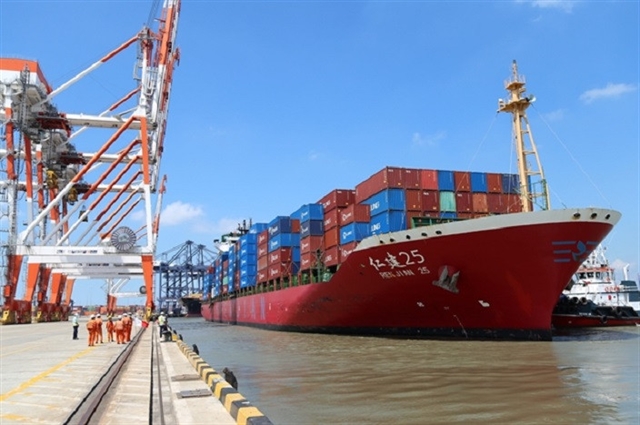 Economy
Economy


|
| The Cái Mép-Thị Vải port in Bà Rịa-Vũng Tàu Province. — Photo vietnamnet.vn |
HÀ NỘI — Seaport congestion in Singapore is affecting the global supply chain, forcing many shipping lines to open new routes to other ports in the region. This is a rare opportunity for Vietnamese seaports to attract more shipping lines around the world.
Many new shipping lines
In recent months, Gemalink Port (belonging to Cái Mép–Thị Vải Port cluster, Bà Rịa-Vũng Tàu Province) has been much busier when welcoming many new service routes. In addition to eight regular weekly ships, the port has received more than ten ad-hoc ships, those outside the fixed schedule, to relieve congested cargo in Singapore.
The Cái Mép International Container Port (CMIT) also received an additional transhipment goods to the port. However, the number of incoming ships was not many and the volume of goods unloaded by shipping lines at the port was not high, according to CMIT General Director Nguyễn Xuân Kỳ.
That said the number of container ship service routes departing from seaports in the Cái Mép-Thị Vải area to European, American and Asian countries recently has grown impressively.
As of July 2024, there are 50 service routes at Cái Mép seaport, including 13 Intra-Asia routes, 19 routes to the Americas, four routes to Europe and one Europe-America route, alongside domestic routes. Particularly at the CMIT port, Zim Shipping Company has deployed several new service routes transferred from Malaysian seaports to Việt Nam.
It is expected that in the third quarter, there will be about two to three more service routes to Europe directly from Cái Mép. Notably, the increase in capacity of this route happens as Singapore ports and some ports in Asia are congested, causing ships to wait for many days.
Shipping lines restructure routes
The Seatrade Maritime reported that the waiting capacity at Singapore's docks has increased to more than 450,000 Teu and many ships even have to wait up to seven days to load cargo, instead of the usual one or two days.
According to the Maritime & Port Authority of Singapore (MPA), the reason is that the crisis in the Red Sea forced ships to change direction around the Cape of Good Hope, changing the ship schedules. The number of incoming ships increased at the same time, causing congestion in Singapore's ports.
Observers say that congestion at Singapore ports has caused some shipping lines to restructure their service routes, shifting cargo transhipment centres from Singapore to other places in Southeast Asia.
For example, Tanjung Pelepas and Northport ports, Malaysia reported record monthly throughput. In May 2024 alone, Tanjung Pelepas handled more than 1 million TEU of goods. Northport of the Port Klang port cluster also benefited, handling 335,361 TEU in May 2024, an increase of 26 per cent over the same period last year.
In Việt Nam, Bà Rịa-Vũng Tàu seaport also benefits. According to statistics from the Vũng Tàu Maritime Port Authority, in the first six months of 2024, the output of goods through ports in the region reached more than 66 million tonnes, an increase of 30 per cent over the same period in 2023. Of which, container cargo reached more than 36 million tonnes, an increase of 37 per cent. Cargo output reached more than 5 million TEU, an increase of 39 per cent. In transit, unloaded goods alone reached more than 650,000 tonnes, an increase of 21 per cent over the same period last year.
While some ports in Cái Mép welcome some new ships, some ports in Hải Phòng City are also expected to have more opportunities to provide services on the Hải Phòng to China route to replace the Hải Phòng to Singapore route.
Risk of congestion
The increase in goods passing through Vietnamese ports is real, Kỳ said, because some shipping firms have launched some routes into Việt Nam to relieve congested goods at Singapore ports. Therefore, shipments are only temporary and short-term, making it difficult to create a new sustainable transhipment point.
"After Singapore resolves the congestion, shipping lines will re-establish routes," Kỳ said.
Deputy General Director of Saigon Port - SSA International Container Services Joint Venture Company Phan Hoàng Vũ said that Cái Mép port has many weaknesses when competing with other ports in the region to be able to replace Singapore's ports.
In terms of scale, Việt Nam's seaports are much smaller than other ports in the region. Typically, the Port Klang port cluster in Malaysia can handle 13 million TEU of goods per year while the Cát Lái port cluster in HCM City can only handle about 10 million TEU a year. In terms of geographical location, Malaysia's seaport also has an advantage as it is located in the Strait of Malacca - an important international maritime route.
"The low price of our seaport loading and unloading services is one of our competitive advantages, but customs services are still complicated," said Vũ, saying that to solve this situation, ports need to link up and share resources to provide shipping lines with the best service or wait for future seaports such as Cần Giờ international transhipment port or ports in the Lower Cái Mép area.
Chairman of the Vietnam Ship Agents, Brokers and Maritime Services Providers Association Phạm Quốc Long said that the output of goods through Cái Mép seaport recently has increased by about 10 per cent due to congestion in Singapore.
"However, a volume of goods arriving at the port cannot be exported because the shipping schedule has changed, while the capacity of many ports is nearly full. The Cái Mép-Thị Vải port cluster has a small warehouse area, the ports are not connected and transporting goods into the inner area is also difficult because there are not many warehouses," said Long. — VNS




